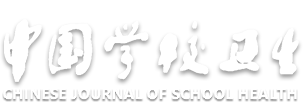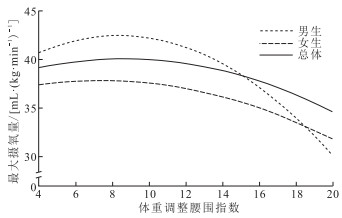Relationship between weight-adjusted-waist index and cardiopulmonary endurance in Chinese middle school students
-
摘要:
目的 了解中学生体重调整腰围指数(WWI)与心肺耐力之间的关联,为青少年心肺耐力水平的提高提供参考和借鉴。 方法 2015年6月—2018年12月采用立意抽样的方法,分别在中国东北、华北、华东、中南、西南、西北地区对44 870名13~18岁中学生进行身高、体重、腰围、20 m往返跑的测试,计算WWI和间接计算最大摄氧量(VO2max)。采用t检验、单因素方差分析的方法进行单因素分析,采用曲线回归分析的方法进行WWI与VO2max关系的分析。 结果 中国13~18岁中学生WWI为(9.35±1.02),20 m往返跑次数为(38.89±18.14)次,VO2max为(39.96±5.88)mL/(kg·min-1)。13~18岁各年龄段男生WWI四分位数组间VO2max比较,差异均有统计学意义(F值分别为15.19,9.00,14.97,20.48,28.13,10.13,P值均<0.01);女生有相同趋势(F值分别为23.36,16.61,33.45,32.96,18.23,19.36,P值均<0.01)。WWI与心肺耐力呈倒U型曲线关系,当WWI为8.5时,VO2max水平达到最高,为40.07 mL/(kg·min-1)。与女生相比,男生WWI对心肺耐力的影响更为显著。 结论 有效控制中学生WWI适宜水平可能更好地促进心肺耐力的提高。 Abstract:Objective To understand the association between weight-adjusted-waist index (WWI) and cardiopulmonary endurance among middle school students, so as to provide references for the improvement of cardiopulmonary endurance levels in adolescents. Methods From June 2015 to December 2018 by using the method of purposive sampling, height, weight, waist circumference, and 20 m shuttle-run tests were measured among 44 870 adolescents aged 13-18 from Northeast, North, East, South, Southwest and Northwest of China. The WWI of the adolescents and the maximum oxygen uptake (VO2max) were calculated indirectly. The t-test and one-way analysis of variance were used for comparison, and the curve regression analysis method was adopted to analyze the relationship between WWI and VO2max. Results For Chinese middle school students aged 13-18, the WWI was (9.35±1.02), the number of 20 m shuttle-run was (38.89±18.14) times, and VO2max was (39.96±5.88) mL/(kg ·min-1). The differences of VO2max between WWI quartile arrays of boys aged 13-18 were statistically significant (F=15.19, 9.00, 14.97, 20.48, 28.13, 10.13, P < 0.01), girls had the same trend (F=23.36, 16.61, 33.45, 32.96, 18.23, 19.36, P < 0.01). There was an inverted U-shaped curve relationship between WWI and cardiopulmonary endurance. When WWI was 8.5, the VO2max level reached the highest, which was 40.07 mL/(kg ·min-1). Compared with girls, WWI in boys had a more significant impact on cardiopulmonary endurance. Conclusion Maintaining optimal WWI levels may enhance adolescents' cardiopulmonary endurance. -
Key words:
- Weight-adjusted waist index /
- Heart /
- Lung /
- Regression analysis /
- Students
1) 利益冲突声明 所有作者声明无利益冲突。 -
心肺耐力作为青少年体质健康的核心要素,对身心健康发展具有重要意义[1-2]。然而,当前我国青少年视屏和轻体力活动行为时间不断延长,锻炼时间减少,体力活动水平下降,导致超重肥胖问题突出,使青少年心肺耐力水平呈现总体下降趋势[3-4]。研究显示,与1985年相比,我国青少年心肺耐力依然处于较低水平[5]。青少年心肺耐力水平与肥胖度、体脂率、腰围等指标存在密切关联[6]。李明等[7]研究显示,中国汉族青少年的体质量指数(body mass index, BMI)与反映心肺耐力的20 m往返跑成绩呈倒“J”形关联。还有研究发现,青少年超重肥胖的发生与心肺耐力呈负相关,提示有效控制超重肥胖的发生是提高青少年心肺耐力水平的重要手段[8]。体重调整腰围指数(weight-adjusted-waist index, WWI)是一种反映身体脂肪分布状况的新型指标,与传统BMI和腰围相比,WWI能更准确地预测心血管疾病和全因死亡率,可能因为WWI通过将腰围与体重进行标准化,不仅考虑了腹部脂肪的分布,还能间接反映肌肉量的变化,从而更全面地评估肥胖程度和身体成分[9-11]。为此,本研究对中国44 870名13~18岁中学生进行调查,分析WWI与心肺耐力之间的关联,旨在为中国青少年心肺耐力水平的提高提供参考和借鉴。
1. 对象与方法
1.1 对象
2015年6月—2018年12月,采用立意抽样的方法,分别在我国东北、华北、华东、中南、西南、西北地区作为抽样区域,在每个地区13~18岁中学生中,采用随机个案法从每个年龄段随机抽取120名男生和女生,共计对44 870名。其中男生22 338名,女生22 532名;平均年龄(15.52±1.67)岁。本研究测试前获得参与者及父母的知情同意,且本研究获得华东师范大学伦理学委员会的审批(HR006-2019)。
1.2 方法
身高、体重和腰围依据全国学生体质健康调研要求的仪器和方法进行测量[12],要求学生穿着轻薄的衣物,身高和腰围测试结果精确到0.1 cm,体重精确到0.1 kg。WWI通过参与者的体重和腰围计算得出,WWI=腰围(cm)/体重(kg)。20 m往返跑的测试在学校田径场进行。当受试者听到蜂鸣声后起跑,跑至距离20 m的对面端线,当再次听到蜂鸣声后再跑至对面端线,反复进行。每跑一次20 m的距离后记录为1次(laps)[13]。当受试者连续2次未能在蜂鸣声提示后达到端线时即为测试结束,记录最后的laps为最终成绩。随后依据测试成绩计算20 m往返跑的等级和最高跑速,并通过公式计算参与者的最大摄氧量(maximal oxygen consumption, VO2max)[14-15]。VO2max=31.025+3.238×S-3.248×年龄+0.153 6×S×年龄。S=8+0.5×测试者达到的最高等级,S表示20 m往返跑最高跑速。测试者达到的最高等级依据最后的次数(laps)得出。1~7 laps为水平1,8~15 laps为水平2,16~23 laps为水平3;测试最高为247 laps,为水平21。
1.3 统计学分析
采用SPSS 25.0软件进行数据录入与分析。不同性别各项目的比较采用t检验。将WWI按照年龄和性别分层后,进行四分位数的划分,不同WWI四分位数组间VO2max的比较采用单因素方差分析,多重比较采用LSD方法。
WWI与VO2max的关系采用曲线回归分析的方法进行。依据VO2max在不同WWI组间呈现先升高后下降的趋势,提出VO2max与WWI之间二次函数(WWI2)关系的假设。为验证该假设是否成立,建立以VO2max为因变量,以WWI为自变量的线性回归模型。检验水准为P<0.05。
2. 结果
2.1 中学生基本指标情况
男生在身高、体重、腰围、WWI、20 m往返跑次数、20 m往返跑等级、20 m往返跑最高跑速、VO2max方面均高于女生,差异均有统计学意义(P值均<0.01)。见表 1。
表 1 不同性别中学生基本指标比较(x ±s)Table 1. Comparison of the basic indicators for middle school students in different gender(x ±s)性别 人数 年龄/岁 身高/cm 体重/kg 腰围/cm WWI 20 m往返跑次数/laps 20 m往返跑等级 20 m往返跑最高跑速/(km·h-1) VO2max/[mL·(kg·min-1)-1] 男 22 338 15.45±1.67 170.95±8.44 60.64±12.89 72.63±10.56 9.39±1.06 46.31±19.66 5.87±2.02 10.94±1.01 42.25±5.90 女 22 532 15.60±1.67 161.55±6.11 52.09±8.70 66.80±7.96 9.30±0.97 31.54±12.77 4.35±1.41 10.18±0.70 37.69±4.89 合计 44 870 15.52±1.67 166.23±8.74 56.35±11.79 69.70±9.79 9.35±1.02 38.89±18.14 5.11±1.90 10.56±0.95 39.96±5.88 t值 -9.05 135.19 82.40 66.11 9.49 94.48 92.75 92.75 89.03 P值 <0.01 <0.01 <0.01 <0.01 <0.01 <0.01 <0.01 <0.01 <0.01 2.2 不同水平WWI中学生VO2max比较
将WWI依据年龄和性别分层后进行四分位数的划分,结果显示,在13~18岁各年龄段,WWI四分位数男生的VO2max比较,差异均有统计学意义(P值均<0.01)。女生方面,在13~18岁各年龄段,WWI四分位数VO2max比较,差异也均有统计学意义(P值均<0.01)。见表 2。
表 2 不同WWI四分位数、不同性别中学生VO2max比较(x ±s)Table 2. Comparison of VO2max in the quartiles of WWI and gender among middle school students(x ±s)WWI 男生 女生 13岁 14岁 15岁 16岁 17岁 18岁 13岁 14岁 15岁 16岁 17岁 18岁 Q1 44.40±4.62 44.01±5.24 43.45±5.83 42.01±6.06 40.40±6.11 38.93±5.89 42.33±3.62 40.54±3.91 38.18±3.82 37.15±3.83 35.57±3.86 33.17±4.43 Q2 45.18±4.96 44.38±5.20 44.10±5.60 42.64±5.98 41.88±6.01 39.38±6.46 42.39±3.75 40.82±3.95 39.29±3.78 37.47±3.66 35.87±4.03 34.13±4.87 Q3 44.56±4.80 44.30±5.08 43.20±5.49 42.21±5.61 41.15±5.81 39.16±6.29 42.30±3.79 40.81±3.79 39.21±3.96 37.10±3.70 35.92±4.03 33.75±4.68 Q4 43.72±4.78 43.29±5.07 42.44±5.23 40.76±5.37 39.36±5.75 37.85±6.00 41.08±4.31 39.64±4.00 37.88±3.59 35.87±3.50 34.64±3.66 32.69±3.75 F值 15.19 9.00 14.97 20.48 28.13 10.13 23.36 16.61 33.45 32.96 18.23 19.36 P值 <0.01 <0.01 <0.01 <0.01 <0.01 <0.01 <0.01 <0.01 <0.01 <0.01 <0.01 <0.01 2.3 中学生WWI与VO2max的曲线回归分析
VO2max与WWI和WWI2的回归分析结果表明,中学生各回归系数均有统计学意义(P值均<0.01)。VO2max与WWI2呈现负相关关系,表明VO2max与WWI构成开口向下的倒“U”型曲线关系,即随着WWI的升高,VO2max呈现先升高后下降的趋势。见表 3。
表 3 不同性别中学生WWI与VO2max的曲线回归分析Table 3. Curve regression analysis of WWI and VO2max in middle school students of different genders性别 自变量 β值 标准误 t值 P值 男 WWI 0.27 0.27 5.65 <0.01 (n=22 338) WWI2 -0.31 0.01 -6.47 <0.01 常数 1.29 27.91 <0.01 女 WWI 0.11 0.28 2.00 0.05 (n=22 532) WWI2 -0.14 0.02 -2.53 0.01 常数 1.32 27.10 <0.01 合计 WWI 0.13 0.21 3.45 <0.01 (n=44 870) WWI2 -0.14 0.01 -3.85 <0.01 常数 1.00 37.08 <0.01 从图 1可知,当WWI为8.5时中学生VO2max水平达到最高,为40.07 mL/(kg·min-1)。当男生WWI为8.5、女生为7.5时,VO2max水平最高,分别为42.47,37.85 mL/(kg·min-1)。男生WWI的升高对VO2max的影响与女生相比更为显著。
3. 讨论
本研究结果显示,中国中学生WWI与反映心肺耐力的VO2max指标之间呈现倒“U”型关系,随着WWI的升高,VO2max水平呈现先升高后下降的趋势。有研究表明,青少年BMI与心肺耐力之间存在“J”型曲线关系[16-17]。还有研究表明,腰围与青少年的心肺耐力之间呈倒“U”型曲线关系,腰围较低和较高均对心肺耐力产生负面影响[18],与本研究结论一致。本研究显示,与BMI、腰围、体脂率相比,WWI在评估中学生心肺耐力方面更具优势,因为WWI能综合考虑体重和腰围,能更全面反映身体成分及脂肪分布对心肺耐力的影响[19]。
WWI对心肺耐力的负面影响其原因可能存在以下方面:(1)WWI的升高意味着体重的增加,而体重的增加使青少年在进行20 m往返跑时需要克服身体更大的体重阻力,势必对测试成绩产生负面影响[20]。Mintjens等[21]对48名15岁青少年进行最大跑台测试结果表明,青少年的BMI与心肺耐力之间呈现负相关。一项对中国青少年的研究也显示,青少年体重的增加对反映心肺耐力水平的1 000 m和800 m跑成绩产生负面影响[22]。(2)腹部脂肪的堆积会导致身体胰岛素抵抗和炎症反应的增加,同时也会导致心血管系统负担加重,影响心肺功能[23]。一项研究表明,身体脂肪的增加会导致代谢需求的升高,需要更多血液循环满足身体基本功能,使心脏负担增加,也会导致心肺耐力水平的下降[24]。(3)脂肪组织的增加会触发身体炎症信号通路,导致脂肪细胞分泌促炎因子,炎症介质通过血液循环扩散至全身,损伤血管内皮细胞,增加心血管血栓形成的风险,最终影响心脏功能,导致心肺耐力水平的下降[25]。
本研究结果还显示,与女生相比,男生WWI对VO2max的影响更为显著,即随着WWI的升高,男生的VO2max水平下降的更为明显。可能因为男生的VO2max水平与女生相比较高,当体重增加时男生相对心肺负担增加的更为显著,导致VO2max水平下降的更为明显。另外,男生与女生的激素水平存在差异,男生主要受到睾酮激素的影响,而女生主要受雌激素和孕激素的影响[26]。睾酮激素有助于维持身体更高的肌肉力量和较低的脂肪量,而WWI的升高导致脂肪的增加,会使雌激素分泌增多,导致男生代谢水平下降,影响心肺功能[27]。
本研究也存在一定的局限性:首先,研究为横断面研究,仅能分析WWI与VO2max之间存在的关联,无法了解两者之间的因果关系。未来应进行前瞻性的队列研究,以分析两者之间的因果关联。其次,研究没有纳入影响青少年心肺耐力的协变量。未来应纳入影响青少年VO2max的饮食行为、体力活动、睡眠等方面的因素,以更好地分析WWI与VO2max之间的关联。
-
表 1 不同性别中学生基本指标比较(x ±s)
Table 1. Comparison of the basic indicators for middle school students in different gender(x ±s)
性别 人数 年龄/岁 身高/cm 体重/kg 腰围/cm WWI 20 m往返跑次数/laps 20 m往返跑等级 20 m往返跑最高跑速/(km·h-1) VO2max/[mL·(kg·min-1)-1] 男 22 338 15.45±1.67 170.95±8.44 60.64±12.89 72.63±10.56 9.39±1.06 46.31±19.66 5.87±2.02 10.94±1.01 42.25±5.90 女 22 532 15.60±1.67 161.55±6.11 52.09±8.70 66.80±7.96 9.30±0.97 31.54±12.77 4.35±1.41 10.18±0.70 37.69±4.89 合计 44 870 15.52±1.67 166.23±8.74 56.35±11.79 69.70±9.79 9.35±1.02 38.89±18.14 5.11±1.90 10.56±0.95 39.96±5.88 t值 -9.05 135.19 82.40 66.11 9.49 94.48 92.75 92.75 89.03 P值 <0.01 <0.01 <0.01 <0.01 <0.01 <0.01 <0.01 <0.01 <0.01 表 2 不同WWI四分位数、不同性别中学生VO2max比较(x ±s)
Table 2. Comparison of VO2max in the quartiles of WWI and gender among middle school students(x ±s)
WWI 男生 女生 13岁 14岁 15岁 16岁 17岁 18岁 13岁 14岁 15岁 16岁 17岁 18岁 Q1 44.40±4.62 44.01±5.24 43.45±5.83 42.01±6.06 40.40±6.11 38.93±5.89 42.33±3.62 40.54±3.91 38.18±3.82 37.15±3.83 35.57±3.86 33.17±4.43 Q2 45.18±4.96 44.38±5.20 44.10±5.60 42.64±5.98 41.88±6.01 39.38±6.46 42.39±3.75 40.82±3.95 39.29±3.78 37.47±3.66 35.87±4.03 34.13±4.87 Q3 44.56±4.80 44.30±5.08 43.20±5.49 42.21±5.61 41.15±5.81 39.16±6.29 42.30±3.79 40.81±3.79 39.21±3.96 37.10±3.70 35.92±4.03 33.75±4.68 Q4 43.72±4.78 43.29±5.07 42.44±5.23 40.76±5.37 39.36±5.75 37.85±6.00 41.08±4.31 39.64±4.00 37.88±3.59 35.87±3.50 34.64±3.66 32.69±3.75 F值 15.19 9.00 14.97 20.48 28.13 10.13 23.36 16.61 33.45 32.96 18.23 19.36 P值 <0.01 <0.01 <0.01 <0.01 <0.01 <0.01 <0.01 <0.01 <0.01 <0.01 <0.01 <0.01 表 3 不同性别中学生WWI与VO2max的曲线回归分析
Table 3. Curve regression analysis of WWI and VO2max in middle school students of different genders
性别 自变量 β值 标准误 t值 P值 男 WWI 0.27 0.27 5.65 <0.01 (n=22 338) WWI2 -0.31 0.01 -6.47 <0.01 常数 1.29 27.91 <0.01 女 WWI 0.11 0.28 2.00 0.05 (n=22 532) WWI2 -0.14 0.02 -2.53 0.01 常数 1.32 27.10 <0.01 合计 WWI 0.13 0.21 3.45 <0.01 (n=44 870) WWI2 -0.14 0.01 -3.85 <0.01 常数 1.00 37.08 <0.01 -
[1] 毕存箭, 尹小俭, 施利娟, 等. 中高强度课堂体育锻炼对藏族初一年级学生心肺耐力和执行功能的干预效果[J]. 中国学校卫生, 2024, 45(3): 322-325.BI C J, YIN X J, SHI L J, et al. Intervention effects of moderate and high intensities of classroom physical activity on cardiorespiratory fitness and executive function among junior grade one students in Tibetan[J]. Chin J Sch Health, 2024, 45(3): 322-325. (in Chinese) [2] 封秀林. 自编有氧拉丁操对女大学生心肺耐力及体育学习兴趣的影响研究[D]. 广州: 广州体育学院, 2024.FENG X L. Study on the impact of self made aerobic Latin exercises on cardio-respiratory fitness and sports learning interests of female university students[D]. Guangzhou: Guangzhou Sport University, 2024. (in Chinese) [3] 李辉, 王乐. 24 h活动行为对中心性肥胖中学生身体形态与心肺耐力影响的替代效益[J]. 中国学校卫生, 2025, 46(5): 662-666.LI H, WANG L. Alternative benefits of 24-hour activity behavior on the physical shape and cardiorespiratory endurance of middle school students with central obesity[J]. Chin J Sch Health, 2025, 46(5): 662-666. (in Chinese) [4] 马奇, 陈曼曼, 马莹, 等. 儿童青少年生活方式与不同部位脂肪质量指数的关联[J]. 中国学校卫生, 2024, 45(7): 1021-1025.MA Q, CHEN M M, MA Y, et al. Association between lifestyle and fat mass index in different positions of children and adolescents[J]. Chin J Sch Health, 2024, 45(7): 1021-1025. (in Chinese) [5] 张帅, 李成跃, 李卫民. 1985—2019年8次中国儿童青少年体质健康监测的爆发力素质研究及长期发展预测[J]. 中国儿童保健杂志, 2025, 33(5): 565-570.ZHANG S, LI C Y, LI W M. Quality of power for monitoring the physical fitness of Chinese children and adolescents based on 8 studies from 1985 to 2019 and long-term development forecasts[J]. Chin J Child Health Care, 2025, 33(5): 565-570. (in Chinese) [6] 陈泽恺, 朱琳, 李展权, 等. 中高强度身体活动量与肥胖儿童青少年心肺适能改善的剂量-效应关系研究[J]. 中国运动医学杂志, 2022, 41(9): 687-693.CHEN Z K, ZHU L, LI Z Q, et al. Dose-response relationship between moderate to vigorous physical activities of and cardiorespiratory fitness of obese children and adolescents[J]. Chin J Sports Med, 2022, 41(9): 687-693. (in Chinese) [7] 李明, 尹小俭, 李玉强, 等. 中国汉族儿童青少年体质量指数与20 m往返跑的相关性[J]. 中国学校卫生, 2017, 38(12): 1773-1776.LI M, YIN X J, LI Y Q, et al. Correlation between BMI and 20 m shuttle run of children and adolescents of Han nationality in China[J]. Chin J Sch Health, 2017, 38(12): 1773-1776. (in Chinese) [8] 土小红, 谢坚明, 黄智萍, 等. 中学生20 m往返跑成绩与生活行为方式的关联[J]. 中国学校卫生, 2022, 43(12): 1804-1808. doi: 10.16835/j.cnki.1000-9817.2022.12.011TU X H, XIE J M, HUANG Z P, et al. Relationship between 20 m shuttle run test performance and lifestyle behaviors of junior high school students[J]. Chin J Sch Health, 2022, 43(12): 1804-1808. (in Chinese) doi: 10.16835/j.cnki.1000-9817.2022.12.011 [9] 李瑞林, 于照祥, 赵斌, 等. 体重调整腰围指数与儿童青少年骨密度的最佳平衡状态探索[J]. 中国骨质疏松杂志, 2025, 31(4): 501-506.LI R L, YU Z X, ZHAO B, et al. Exploration of the optimal balance between weight-adjusted waist circumference index and bone mineral density in children and adolescents[J]. Chin J Osteop, 2025, 31(4): 501-506. (in Chinese) [10] WANG X, YANG S, HE G, et al. The association between weight-adjusted-waist index and total bone mineral density in adolescents: NHANES 2011-2018[J]. Front Endocrinol (Lausanne), 2023, 14: 1191501. doi: 10.3389/fendo.2023.1191501 [11] YE J, HU Y, CHEN X, et al. Association between the weight-adjusted waist index and stroke: a cross-sectional study[J]. BMC Public Health, 2023, 23(1): 1689. doi: 10.1186/s12889-023-16621-8 [12] 黄凤连, 陈萍萍, 周圆, 等. 基于中国学生体质调研数据的少数民族中小学生视力不良对比分析[J]. 中国校医, 2021, 35(5): 321-324.HUANG F L, CHEN P P, ZHOU Y, et al. Comparative analysis of poor visual acuity of minority primary and secondary school students based on Chinese students' physique and health survey data[J]. Chin J School Doctor, 2021, 35(5): 321-324. (in Chinese) [13] TOMKINSON G R, LANG J J, BLANCHARD J, et al. The 20-m shuttle run: assessment and interpretation of data in relation to youth aerobic fitness and health[J]. Pediatr Exerc Sci, 2019, 31(2): 152-163. doi: 10.1123/pes.2018-0179 [14] 石秀廷, 尹小俭. 20 m往返跑用于青少年心肺耐力评价的研究进展[J]. 中国学校卫生, 2017, 38(12): 1916-1920.SHI X T, YIN X J. Research progress of 20 m round trip running for evaluating cardiopulmonary endurance in adolescents[J]. Chin J Sch Health, 2017, 38(12): 1916-1920. (in Chinese) [15] LÉGER L A, MERCIER D, GADOURY C, et al. The multistage 20 metre shuttle run test for aerobic fitness[J]. J Sports Sci, 1988, 6(2): 93. doi: 10.1080/02640418808729800 [16] 刘自慧, 彭莉, 郭耀明, 等. 重庆市儿童身体质量指数与体质健康指标关系研究[J]. 西南师范大学学报(自然科学版), 2013, 38(12): 164-168.LIU Z H, PENG L, GUO Y M, et al. On relationship between body mass index and physical health variables of Chongqing children[J]. J Southwest China Norm Univ (Nat Sci Edit), 2013, 38(12): 164-168. (in Chinese) [17] 王熙, 王娇娇, 张强, 等. 儿童青少年体格发育指标与20 m往返跑成绩的关联[J]. 中国学校卫生, 2023, 44(11): 1708-1712.WANG X, WANG J J, ZHANG Q, et al. Relationship between anthropometric parameters and 20-meter shuttle run test among children and adolescents[J]. Chin J Sch Health, 2023, 44(11): 1708-1712. (in Chinese) [18] 李新, 李晓彤, 王正珍, 等. 肥胖少年颈围、腰围与心肺耐力及心血管疾病危险因素的关系[J]. 体育科学, 2017, 37(3): 79-85.LI X, LI X T, WANG Z Z, et al. Relationship of neck circumference, waist circumference and cardiorespiratory fitness with cardiovascular disease risk factors in obese adolescents[J]. Sci Sports, 2017, 37(3): 79-85. (in Chinese) [19] WEELDREYER N R, DE GUZMAN J C, PATERSON C, et al. Cardiorespiratory fitness, body mass index and mortality: a systematic review and Meta-analysis[J]. Br J Sports Med, 2025, 59(5): 339-346. doi: 10.1136/bjsports-2024-108748 [20] 赖丽娟, 蔡莉, 曾霞, 等. 广州市小学生体力活动和静态行为与20 m往返跑的关联[J]. 中国学校卫生, 2019, 40(12): 1771-1774.LAI L J, CAI L, ZENG X, et al. Association of physical activity and sedentary behavior with 20 in shuttle run test performance among children[J]. Chin J Sch Health, 2019, 40(12): 1771-1774. (in Chinese) [21] MINTJENS S, MENTING M D, DAAMS J G, et al. Reply to tarp comment on: "cardiorespiratory fitness in childhood and adolescence affects future cardiovascular risk factors: a systematic review of longitudinal studies"[J]. Sports Med, 2019, 49(1): 163-165. doi: 10.1007/s40279-018-01042-0 [22] 梅凤鸣. 同期耐力与力量训练对非体育专业大学生800米成绩影响的实验研究[D]. 长春: 吉林体育学院, 2024.MEI F M. An experimental study on the influence of simultaneous endurance and strength training on 800 meter performance of non-physical education major college students[D]. Changchun: Jilin Institute of Physical Education, 2024. (in Chinese) [23] KOSMAS C E, BOUSVAROU M D, KOSTARA C E, et al. Insulin resistance and cardiovascular disease[J]. J Int Med Res, 2023, 51(3): 655741820. [24] ASHRAF M J, BAWEJA P. Obesity: the 'huge' problem in cardiovascular diseases[J]. Mo Med, 2013, 110(6): 499-504. [25] SOTAK M, CLARK M, SUUR B E, et al. Inflammation and resolution in obesity[J]. Nat Rev Endocrinol, 2025, 21(1): 45-61. doi: 10.1038/s41574-024-01047-y [26] MCHENRY J, CARRIER N, HULL E, et al. Sex differences in anxiety and depression: role of testosterone[J]. Front Neuroendocrinol, 2014, 35(1): 42-57. doi: 10.1016/j.yfrne.2013.09.001 [27] WANG P, LI Q, WU L, et al. Association between the weight-adjusted-waist index and testosterone deficiency in adult males: a cross-sectional study[J]. Sci Rep, 2024, 14(1): 25574. doi: 10.1038/s41598-024-76574-9 -







 下载:
下载:


 下载:
下载:

